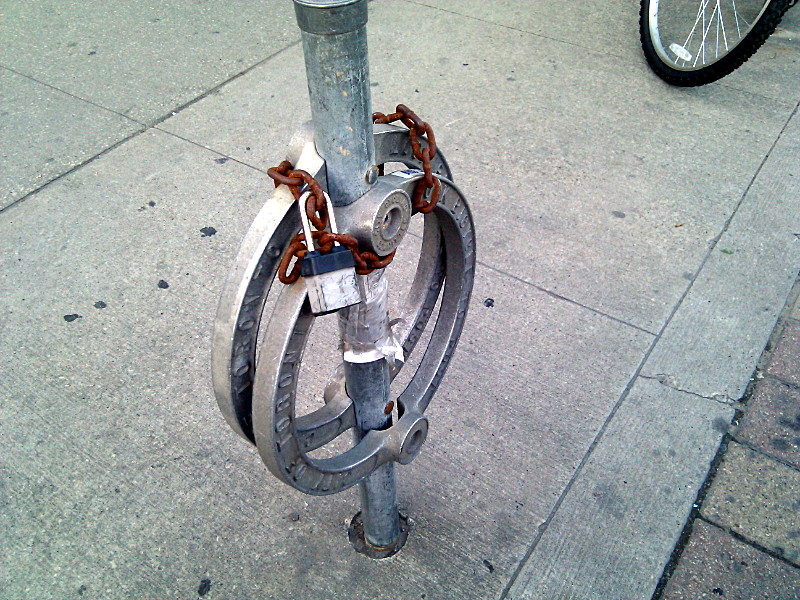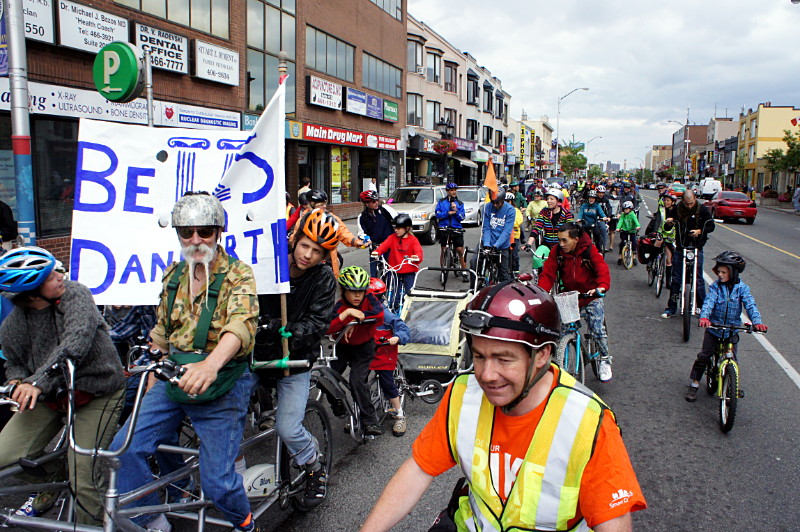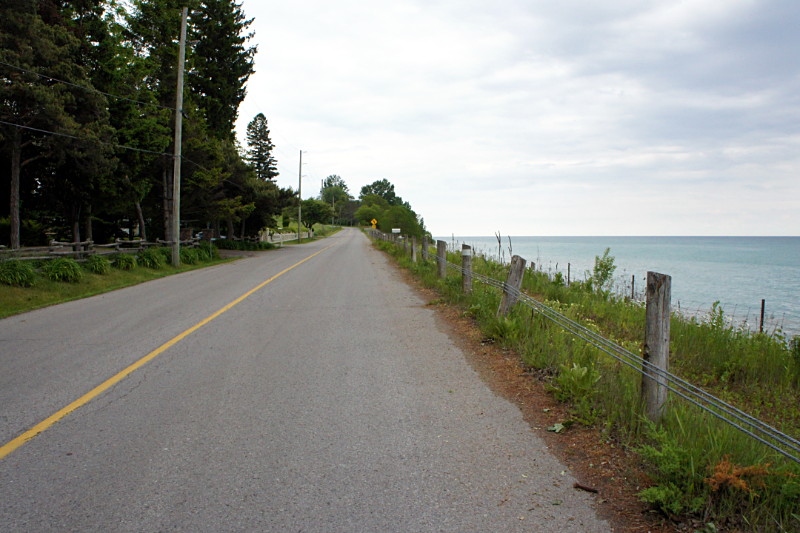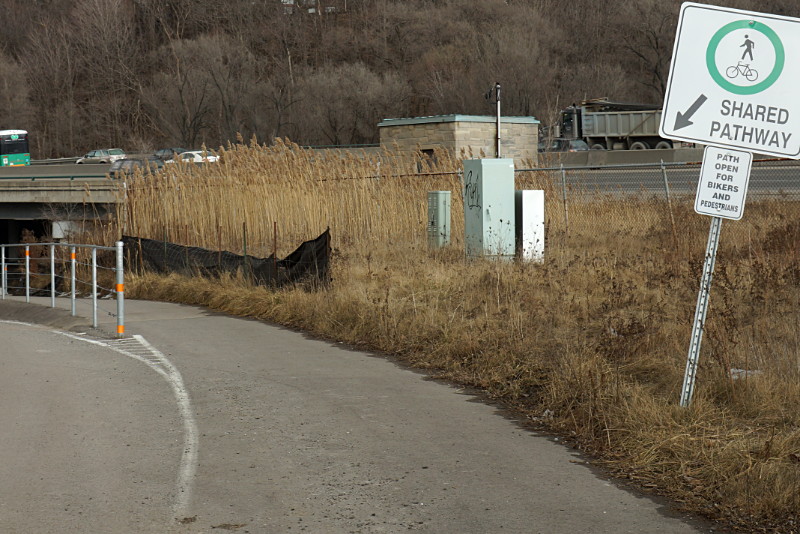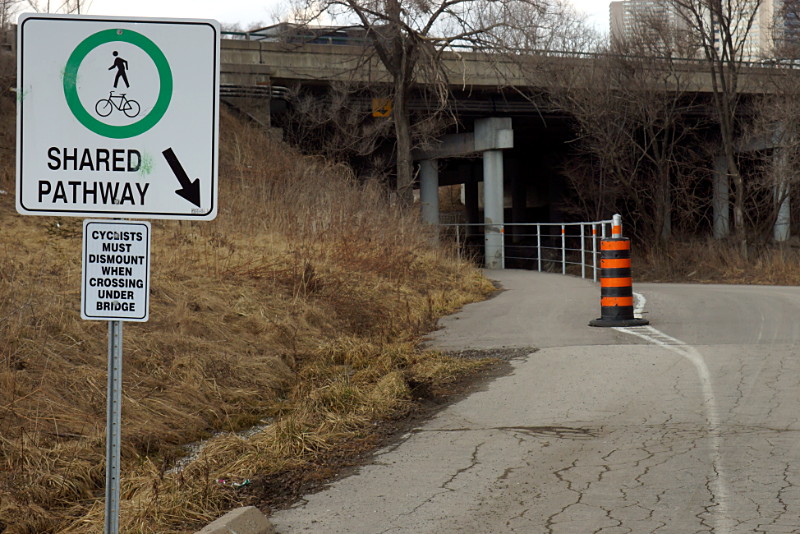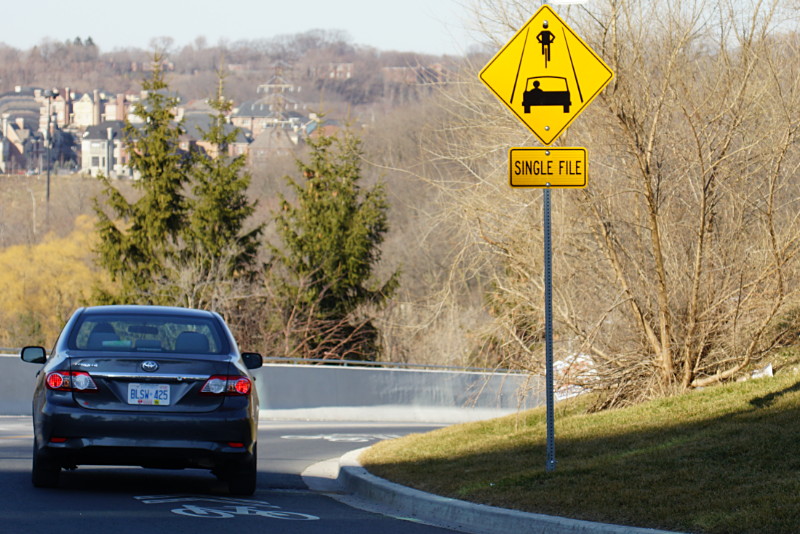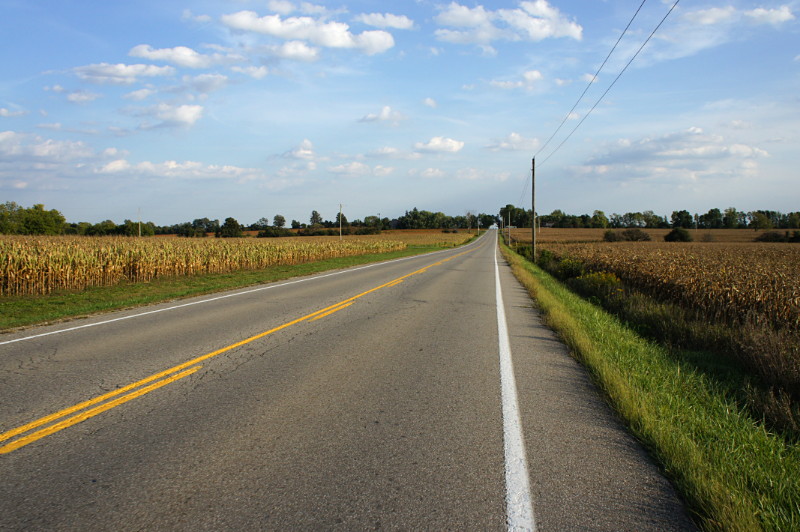
The farm-lined road to Anywhere, southern Ontario.
First, a travel tip for anyone taking a bike into the York Mills GO terminal: the canonical way to get to the bus platforms is to go into the York Mills Centre at the northeast corner of Yonge and York Mills, take the well-hidden elevator up to the second floor, and then walk down a short flight of stairs. It’s not so bad on foot, but it’s an overly complicated two-step when you’re swinging a loaded bike around. It’s way more convenient to ride just a few more metres north up Yonge to the same portal that the buses use and ride in through that as if you owned the place. It’s not only a shorter and easier route to the platform, but it means you don’t have to shoulder your bike down stairs or make everyone in the elevator miserable. It’s also far safer. You won’t be riding into a fare-paid zone, so it’s not like you’re doing anything underhanded.
I made a multi-modal trip to Kitchener this weekend (I’ll write more about that in the future), taking GO Transit to Guelph and cycling from there to Kitchener on Friday morning, and then reversing the trip on Sunday evening. Riding the roughly 28 km from Guelph to Kitchener is unlike riding in the countryside anywhere near Toronto. Oh sure, you’ve got the same corn fields, roadside ruminants, sod farms, rural communities, and quiet country roads, but the terrain is remarkably flat. There were only two noticeable hills for the entire ride and even those were smaller than climbing up Danforth from Coxwell to Woodbine. I’m used to traversing the Oak Ridges Moraine or climbing hills on hills on hills in the Peterborough drumlin field when I ride in the country, so riding somewhere flat is quite a treat.
Highway 7 provides the shortest and most direct route between the two cities, but it’s not very pleasant to ride on. A more southerly route along Wellington 124 is about 5 km longer but it’s at least 10 km nicer to ride on. I took a middle way to Kitchener that had theoretical advantages over taking 124: the route along Fife Road is both quieter and shorter by almost 3 km. It also has a long stretch of riding on dirt roads, which doesn’t usually bother me. It would have been perfect if I hadn’t been riding in Friday’s rain, which begat mud, which begat a poorly functioning drivetrain, which begat sucking the fun out of the ride. I was insanely happy that my hotel room was ready three hours before check-in time. “How are you today Mr. Dodge?” “A little muddy.” “I see that.” In total, the ride from downtown Guelph to downtown Kitchener was 28.5 km and took 90 minutes in the rain with a malfunctioning rear derailleur that left me more or less stuck in an awkward gear.
Sunday’s evening’s return trip was sunny and warm (see the picture above) with a steady tailwind. I took advantage of the tailwind to ride the slightly longer return route along Kossuth Road and Wellington 124. Both of those roads have nice wide paved shoulders for most of their length and are easy to ride on if not quite as scenic as some of the quieter rural roads. The return trip was 30.5 km in just 75 minutes with a tailwind blowing all the way. Not bad for a loaded mountain bike. I’d recommend the Fife Road route if it’s dry and you don’t mind riding on dirt roads. I don’t think I’d do it on my road bike. If you want a smooth ride that’s relatively fast but with less traffic than Highway 7, take Wellington 124 and Kossuth Road. You’ll have to head either north or south to cross the Grand River into town; take whichever way is the shorter route to your ultimate destination.
If you’re so inclined, you can read a more detailed ride report below the fold.
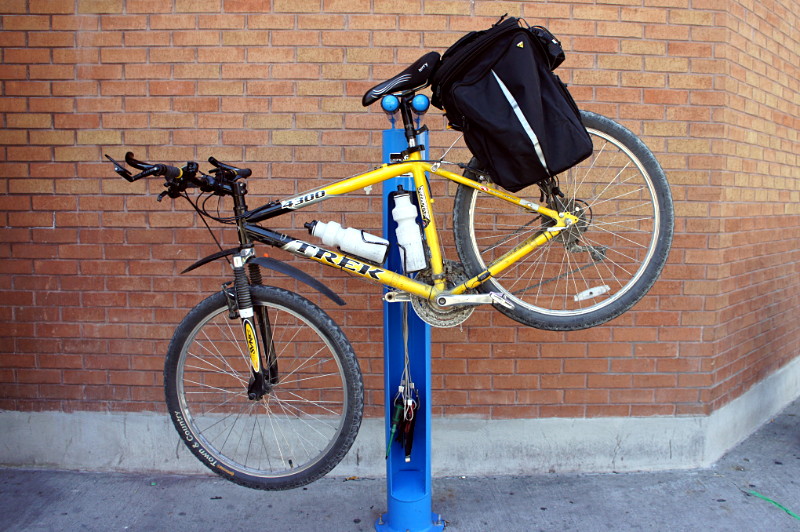
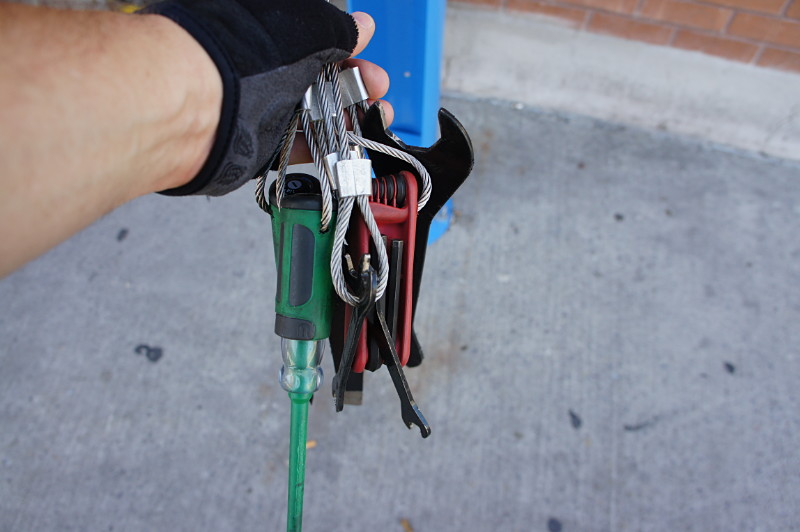
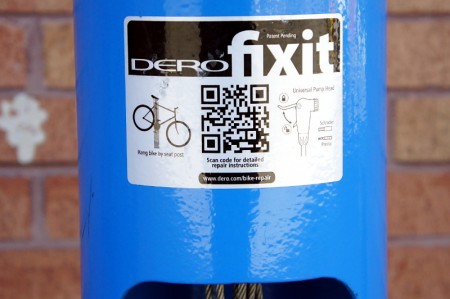 This is the kind of cycling infrastructure that I love: it’s incredibly useful for both casual and seasoned riders and just sits unobtrusively in the background until it’s needed. The only thing missing from the stand is a pump, which is probably the one tool that would be used the most. Susan Sauvé, a transportation planner at the city, told me via email that pumps were originally included with the stands when they were installed in July, but they all broke within a week. The city currently has more durable pumps on order from the manufacturer and hopes to re-install them soon.
This is the kind of cycling infrastructure that I love: it’s incredibly useful for both casual and seasoned riders and just sits unobtrusively in the background until it’s needed. The only thing missing from the stand is a pump, which is probably the one tool that would be used the most. Susan Sauvé, a transportation planner at the city, told me via email that pumps were originally included with the stands when they were installed in July, but they all broke within a week. The city currently has more durable pumps on order from the manufacturer and hopes to re-install them soon.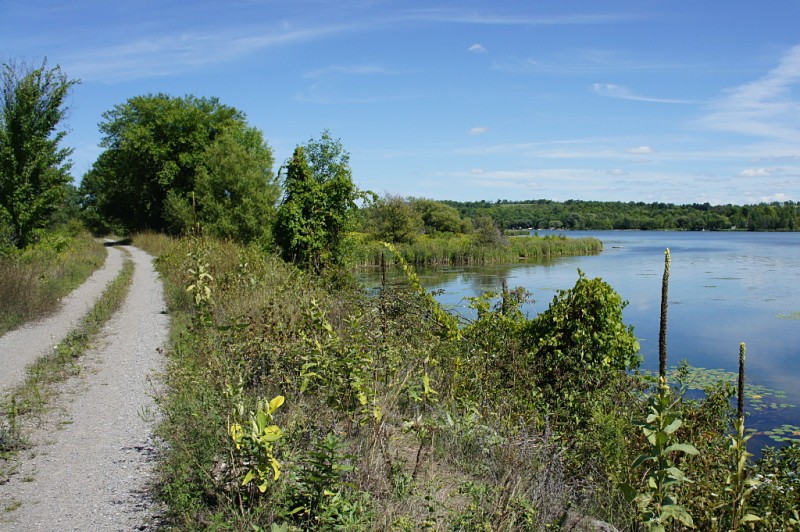
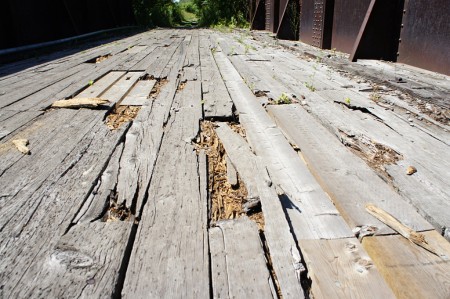 Compared to the Peterborough to Omemee trail, the lack of coordination shows: the route to Hastings is a little more wild and a bit more of a challenging ride. Unlike the smooth wide bed of gravel dust on the Omemee trail, the ride to Hastings is mostly on dirt double-track with some large gravel, loose sand, and other trail hazards along the way. Some of the bridges seemed to be in rough shape, with some surface planks rotting away and exposing holes big enough to see through to the rivers below. The trail is probably smooth as butter when it’s covered with a couple of feet of hard packed snow but it can be a little jarring on a bike in the summer. It’s certainly in good enough condition and offers enough variation for an average cyclist to have an enjoyable trip, but you won’t find any beach cruisers on it. Front suspension on my mountain bike was most welcome by the halfway mark.
Compared to the Peterborough to Omemee trail, the lack of coordination shows: the route to Hastings is a little more wild and a bit more of a challenging ride. Unlike the smooth wide bed of gravel dust on the Omemee trail, the ride to Hastings is mostly on dirt double-track with some large gravel, loose sand, and other trail hazards along the way. Some of the bridges seemed to be in rough shape, with some surface planks rotting away and exposing holes big enough to see through to the rivers below. The trail is probably smooth as butter when it’s covered with a couple of feet of hard packed snow but it can be a little jarring on a bike in the summer. It’s certainly in good enough condition and offers enough variation for an average cyclist to have an enjoyable trip, but you won’t find any beach cruisers on it. Front suspension on my mountain bike was most welcome by the halfway mark.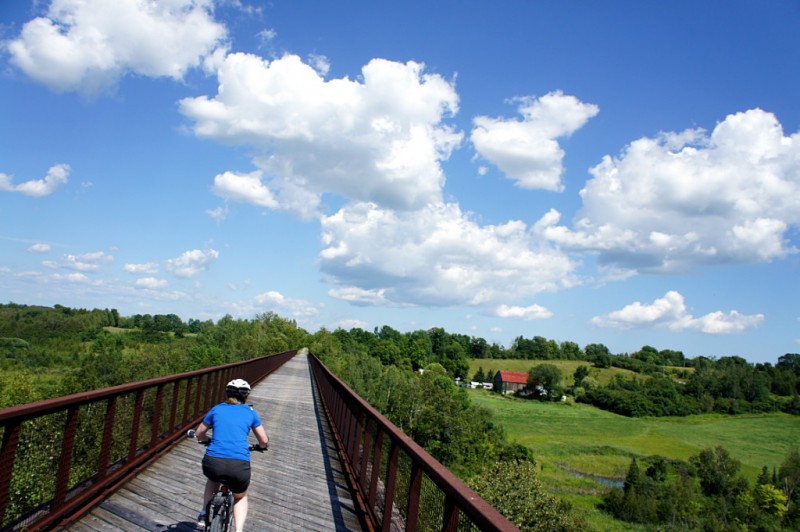
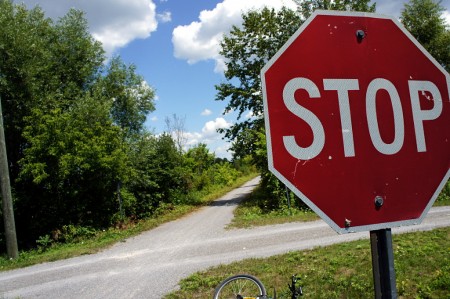 The trail is an easy and relaxing ride for the entire length. It passes a few rural intersections and driveways at grade, while busy Highway 7 and some other driveways are carried over the trail on bridges. The urban intersections in Peterborough are similar to the ones on Toronto’s Beltline, but have curb cuts to actually let cyclists cross at the trail. The trail itself is well-maintained and can be ridden by the most casual of cyclists. Along the way you are treated to views of farms, valleys, and the rolling hills that you are not constantly climbing up and down. That’s the real joy of rail trails: you may be climbing, but the grade is so slight that it doesn’t hurt when you’re going up and it’s like having a slight tailbreeze when you’re going down.
The trail is an easy and relaxing ride for the entire length. It passes a few rural intersections and driveways at grade, while busy Highway 7 and some other driveways are carried over the trail on bridges. The urban intersections in Peterborough are similar to the ones on Toronto’s Beltline, but have curb cuts to actually let cyclists cross at the trail. The trail itself is well-maintained and can be ridden by the most casual of cyclists. Along the way you are treated to views of farms, valleys, and the rolling hills that you are not constantly climbing up and down. That’s the real joy of rail trails: you may be climbing, but the grade is so slight that it doesn’t hurt when you’re going up and it’s like having a slight tailbreeze when you’re going down.